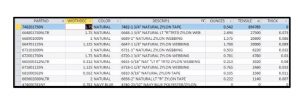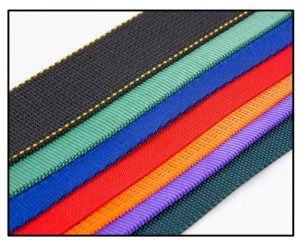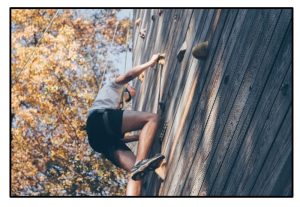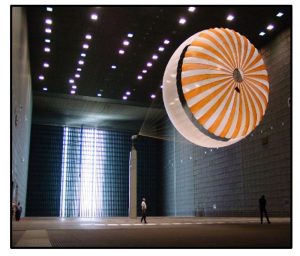
The art and science of developing end materials for challenging new applications
By Ted Fetterman
In the fashion world, textile development is both an art and a feel. Industrial fabric applications do not follow quite the same pattern — they focus more on performance than style. However, there is still an interaction between the customer and the fabric, and most product developers want to touch the fabrics and work with them before using them in an industrial application. To ensure that a woven webbing fabric meets the performance requirements of an application in particular environmental conditions, it is critical that all are prototyped and tested.
What is driving the need for prototype development?
Two very different types of product development drive the need for a custom prototype.
One primary driver is product developers’ need for woven materials that meet the performance requirements of a particular new application. Developers trying to match up all the application performance requirements to an available solution often begin by conducting a simple Internet search on textiles based on published fiber performance and chemistry criteria. Textiles that meet established published specifications offer material performance predictability, but because applications are so unique, testing of prototypes is always required.
The other frequent impetus stems from a chemical company’s development of a novel polymer combination that lends itself to a fiber application. The chemical company then looks for applications for that chemistry and may approach original equipment manufacturers (OEMs) with the new fiber. The OEM in turn may have an application in mind – if they could get the material woven into a narrow fabric. At that point, chemical companies often contact woven webbing manufacturers like BRM to create a textile architecture in which the end material highlights the inherent chemical properties of the fiber. To ensure the fabric is fit for the desired end use and can be guaranteed to perform for a particular purpose and in specific environmental conditions, the customer must perform engineering and testing on a prototype.

All applications are unique
All applications feature unique characteristics — they rarely fit into a neat box. This is because, while woven fabrics themselves can be guaranteed to meet material design specifications, it is not possible to predict the performance of any particular woven material for all applications. For example, all materials to be used on the lunar surface must be designed to function within extreme temperatures: daytime on the moon’s equator can be as high as 90°C and nighttime temperatures can be as low as -200°C. Materials must also meet ultraviolet (UV) degradation requirements; prototypes are used to test for exposure time, amount of radiation, and type of radiation.
At BRM, every inquiry goes through a process that includes a regimented data creation method. Extensive sampling is performed on everything woven, dyed, and finished. All information is entered into a vast database of test data linked to all manufacturing processes. Application experts draw from this information during the product development stage to pair products with customer needs.
As one of the few textile companies with such an extensive database, BRM has become a go-to supplier to NASA. The company plays a prominent role in development of material for the US Department of Defense through many of its R&D offices and labs. BRM is also working with the Parachute Industry Association (PIA), US Army Research Laboratory (DEVCOM) and US Defense Logistics Agency to update, modify, and validate modifications to US Mil-specs and PIA specs to regulate quality.
Digging deeper into the prototyping process
When discussing prototyping in woven fabrics, it is important to note that all projects are prototyped and tested for the application — whether BRM has off the shelf fabrics or develops a new fabric.
The process begins with communication between the customer and BRM to understand the application, either using face to face communication or virtual platforms. The customer may show drawings and BRM shares relevant test report information. Then it is time for the prototype stage.
To save time and money, most customers start off wanting to incorporate an existing, off the shelf fabric into their development process. The majority can be handled by an in-stock fabric. Putting samples in fabricators’ hands is critical; samples may be sent for an initial evaluation, based on the project scope. BRM might send several materials that are close to one another but different in some way, along with data sheets or test reports. These prototypes will be tested by the customer for actual application performance with regard to thickness, tensile strength, and the effects of UV or saltwater.
When the project cannot use an off the shelf item, BRM must come up with a new solution to meet the requirements. BRM uses a rigorous regulated project planning control process for custom prototyping — an extensive step by step review of the application to determine what would be necessary to satisfy the customer and mitigate any business risk.
Weaving experts review all the specifications to gain a deep understanding of the environment the fabric will be used in, and what type of chemistry is required. They then enter into a product development agreement for a particular application, which includes producing prototypes for detailed customer testing. For example, BRM tensile strength tests are conducted using an approved ASTM method and known information on the mechanics of the material. However, while speed can be controlled in the lab, customer testing is required to model all dynamic forces under high speed conditions.
In most cases, customers want prototypes to blow apart and model through observation rather than benchtop studies. For example, space programs use prototypes to test the interaction of propellants with all structural materials in the vehicle, including webbing.
The U.S. federal government maintains considerable mechanical engineering laboratory resources for this type of testing. It has been increasing its focus on gathering enough data to predict performance of materials in extreme environments to satisfy recent mission requirements pushing these limits.

Using prototyping process to help come up with a new solution
BRM uses a careful iterative process to come up with new fabric prototypes. When benchtop analysis to eliminate variables has been exhausted, application experts take a snapshot and determine which variables have not been eliminated. Then weaving experts go to the loom and weave a new fabric, using the ideas collected on potential changes in the loom. It is not an exact science — customers know that they will not know how the fabric will actually perform until it has been blown apart. In recent years, BRM has also increased its level of non-destructive testing. Rather than destroying the material at extremes, experts conduct cycle and abrasion testing to measure the effect of some stimulus to the material.
Everything done on the loom is meticulously documented, including any and all changes to the formulation. Internal test results on effects of changes are compiled. Customer testing provides additional feedback, which may lead to another round of changes.
One recent example of the importance of the prototyping process was a project for the recreational climbing market. The customer wanted to develop a stronger yet lighter material for use in sewn slings, structural loops of webbing used to fix gear to a climber or the mountain. This market is driven by weight, and the industry is always looking to get the same or better performance while reducing weight.
The customer wanted higher strength in the base tubular webbing. Established materials for this application must pass a standard — 22 kilonewtons (kN) over a 10 millimeter pin, the diameter of carabiner and connector in the climbing market. A standard sling has a substantial through-thickness and placing the sewn loop over the pin creates internal forces. In substituting material, BRM used a more densely packed yarn to achieve the desired increased strength. Changing just one variable in the weave structure changed the dynamic of the webbing, and the internal pressure forces caused the webbing to melt. This could not have been predicted without testing the solution using a prototype.
After getting the new and unexpected result, the next step was a forensic analysis of the material to understand why it melted. Application experts found that the high tenacity fiber used had a low melt point (lower than nylon) and the pressure caused heat. A visual analysis revealed that the loop had melted into a hard plastic mass, indicating the issue was generated by heat and not mechanical force. After the analysis, the application team investigated ways to modify the design to reduce the density and allow the fibers to be efficiently incorporated into the design without such high pressure. Lowering the fiber content reduced the density of the weave, which allowed all the fibers to load evenly, thereby increasing the woven structure’s tensile yield. BRM regularly applies the concept when trying to increase the performance yield of the fiber inputs.

Weight reduction is also driving development in the aerospace market. For outer space/NASA applications, it is expensive per pound to transport material from earth to the moon. The same is true in commercial aviation. For example, one current space application project that required higher performance materials for use as a tensile structure and mechanism for actuating a robotic arm on the moon began with standard mechanical engineering specifications but had to be tailored for the extreme environment found on the on surface of the moon. The process included several rounds of discussions and specification requirement changes to the base fiber. BRM and the customer are currently in the process of designing and testing multiple samples, and one will be downselected as the way to go forward.
A third example illustrates the importance of an iterative prototype production and testing process for new applications. It also underscores the challenge of understanding the relationships among the variables, even with a good understanding of the variables present from inputs. The project involves product development on comingled structural fibers with thermoplastic fibers. BRM fabric experts are investigating the properties and values if the material is woven into two-dimensional or three-dimensional woven structures. Three weave design material combinations are being tested to evaluate the performance characteristics of the design combination. While increased interlaminar sheer properties were desired and initially predicted, the increase in strength result was not ideal. However, energy absorption and dissipation properties was discovered to be more valuable as a result of the design.
Finally, prototyping is also valuable for medical applications, though it is less prevalent. The medical arena is a known environment. Performance is well-established and only certain fabrics can be implanted. For example, BRM has long made woven tubular materials used as structural component material for arterial stents and grafts. The woven structures are further processed by medical device manufacturers. In recent years, medical research and development has been focused on smaller and smaller structures, which have been difficult to achieve with existing yarn sizes. BRM is undertaking development with a textile yarn producer, reducing the size of yarn so structures can be smaller and smaller. For this application, prototypes of iterations is the path towards understanding weavability of a new fiber.
Prototyping reaps huge benefits
Prototype development in the webbings market has reaped enormous benefits to customers in a wide range of industries. There are limitations to internal testing – customer prototype testing is essential to ensure performance of the test material relative to the application and environmental conditions in which it will operate.
Editor’s Note: Ted Fetterman is director of sales and marketing, Bally Ribbon Mills, Bally, Pa.
September 23, 2021




